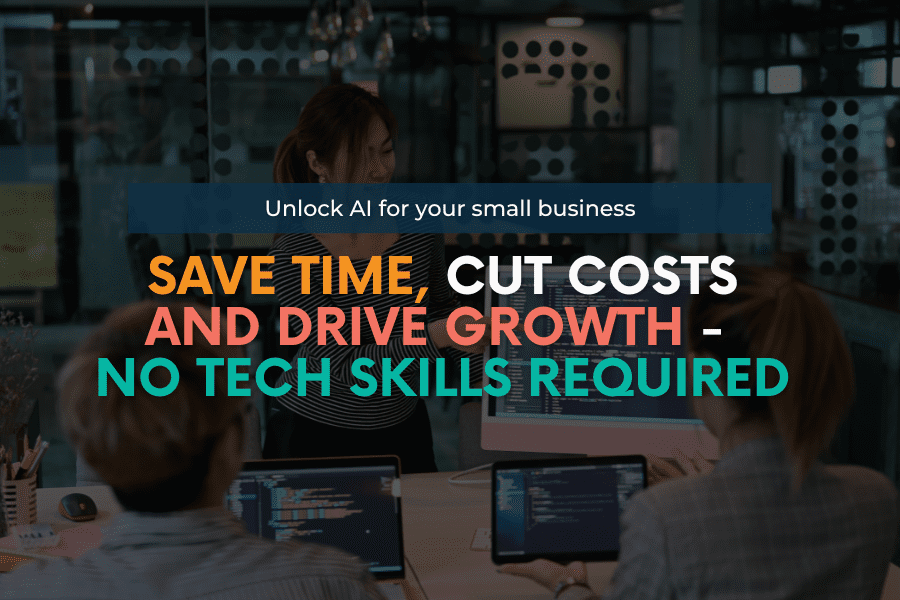Chamber News
Follow Us
AI Basics For Small Business Owners

Where to start and what to know
Artificial intelligence (AI) is no longer reserved for tech giants or data scientists. It’s reshaping how businesses operate, offering tools to save time, cut costs, and drive growth. But for small business owners, the idea of integrating AI can seem intimidating. The good news? You don’t need a tech background to get started. This guide will walk you through the basics of AI, its benefits, and how to integrate it into your business operations.
What is AI, and why does it matter for small businesses?
At its core, AI refers to technology that mimics human intelligence to perform tasks like learning, problem-solving, and decision-making. For small businesses, AI is an invaluable tool. It can:
- Automate repetitive tasks: Free up time by handling routine operations like scheduling or inventory tracking.
- Improve customer service: AI-powered chatbots can answer questions 24/7, improving customer satisfaction.
- Boost marketing efforts: Tools like personalised email campaigns or targeted ads use AI to increase engagement and ROI.
Whether you’re running a local boutique or managing a growing online store, AI offers opportunities to streamline operations and compete with larger players.
Curious about what AI can do for your business? Check out this insightful resource from Small Business NSW.
Common AI tools small businesses can use
AI tools are more accessible than ever, with many designed specifically for non-tech-savvy users. Here are some options to explore:
- Marketing:
- Mailchimp: Use AI to personalise email campaigns and predict customer behaviour.
- Canva Magic Write: Generate social media captions and marketing copy quickly.
- Customer support:
- ChatGPT or Tidio: Set up chatbots to handle FAQs and provide instant responses.
- Finance:
- QuickBooks: Automate expense tracking and generate financial reports with AI insights.
- Productivity:
- Calendly: Streamline appointment scheduling with AI-powered suggestions.
- Microsoft AI Copilot: Integrate AI into tools like Word and Excel for smarter workflows.
Most of these tools offer free trials or affordable pricing plans, making them ideal for small businesses.
Steps to start using AI in your business
If you’re new to AI, here’s how to get started:
- Identify pain points
Think about tasks that consume time or resources. Is managing social media posts a hassle? Do you spend hours responding to customer inquiries? These are areas where AI can help. - Start small
Choose one area to focus on, such as automating email marketing or setting up a chatbot for customer support. Starting small reduces risk and allows you to see immediate benefits. - Do research
Explore AI tools that fit your needs. Look for user reviews, tutorials, and webinars to understand their capabilities. Many tools are designed for ease of use, even for beginners. - Experiment and test
Use free trials to test different tools. Experiment with their features to see how they can integrate into your business operations. For instance, try generating social media captions using an AI-powered tool like Jasper. - Ask for help
Don’t hesitate to involve your team or consult an expert. Collaboration can make the transition smoother and help everyone understand how to use the tools effectively.
By taking these steps, you’ll build confidence in using AI and gradually integrate it into more areas of your business.
Overcoming challenges and misconceptions
Many small business owners worry that AI is too expensive or complex. The truth is:
- Affordability: Most AI tools are scalable, offering tiered pricing plans to suit different budgets. Free versions or trials are often available.
- Ease of use: Modern AI tools prioritise user-friendly interfaces and require little to no technical knowledge.
- Human jobs: AI is not about replacing employees but helping them to focus on higher-value tasks by automating repetitive ones.
For example, a small bakery might use AI to automate order tracking while staff focus on customer service and product quality.
Final thoughts
AI is no longer a luxury reserved for large corporations. It’s a practical, accessible tool that can help small businesses save time, reduce costs, and improve operations. By starting small and focusing on your business’s specific needs, you can integrate AI in a way that’s both effective and manageable.
Remember, you don’t need to be a tech expert to use AI. Take that first step, try out a tool, and see how it can help your business. The future of AI is here—and it’s waiting for you to take advantage of it.















